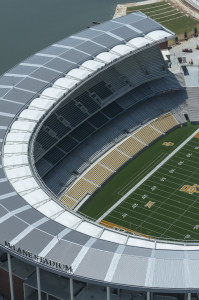
Baylor University in Waco, Texas, prides itself on its football program and demanded “a first-class facility for a first-class university and sports program,” says Douglas Radcliffe, business development manager for membrane canopy expert Birdair North America, Buffalo, N.Y. Waco’s subtropical climate, characterized by hot summers and mild winters, can produce 90-degree temperatures during any month of the year, so when designing the new Baylor University McLane Stadium, Baylor officials and architect Populous reached out to Birdair for a shade canopy to cover the U-shaped facility’s leading roof edge.
The new home of the Baylor Bears promises to become a catalyst for economic development along the Brazos River. The stadium features more than 42,000 permanent seats, suites, private boxes and multiple function rooms for year-round use, as well as 2,500 on-site parking spaces. Birdair’s canopies shade 45 to 55 percent of the seats throughout the day, reflecting as much as 73 percent of the sun’s energy. The stadium canopies required 35,000 square feet of PTFE fiberglass membrane material tensioned between supporting structural steel.
Birdair’s trademark PTFE fiberglass membranes endure in climates from arctic cold to desert heat, with project lives sometimes exceeding 30 years. The lightweight membrane can span very large ranges, allowing cost savings on steel, lighting (13 percent of natural daylight shows through the canopy fabric) and reduced maintenance.
 TEXTILES.ORG
TEXTILES.ORG


